Raid on Havre de Grace
Introduction
Text-to-speech Audio
Images
A contemporary sketch shows Admiral Cockburn overseeing the burning of Havre de Grace
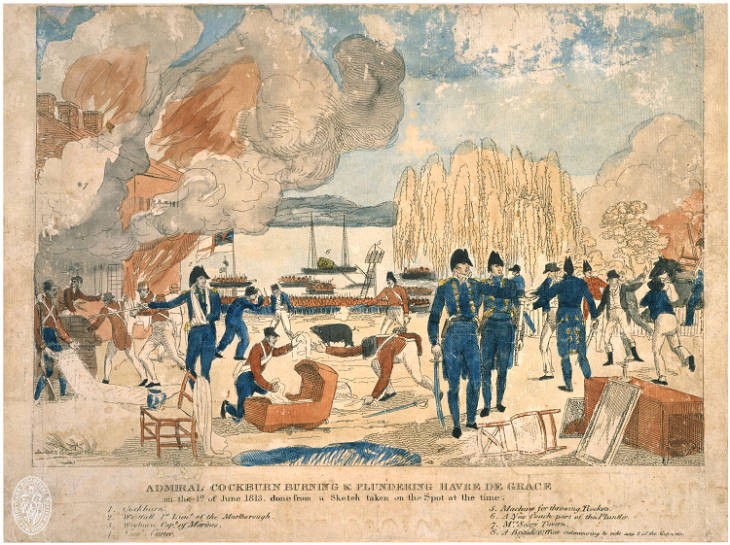
Admiral George Cockburn
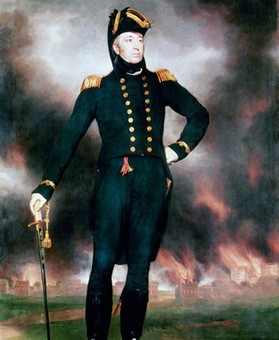
Map of the Upper Chesapeake Bay during the War of 1812
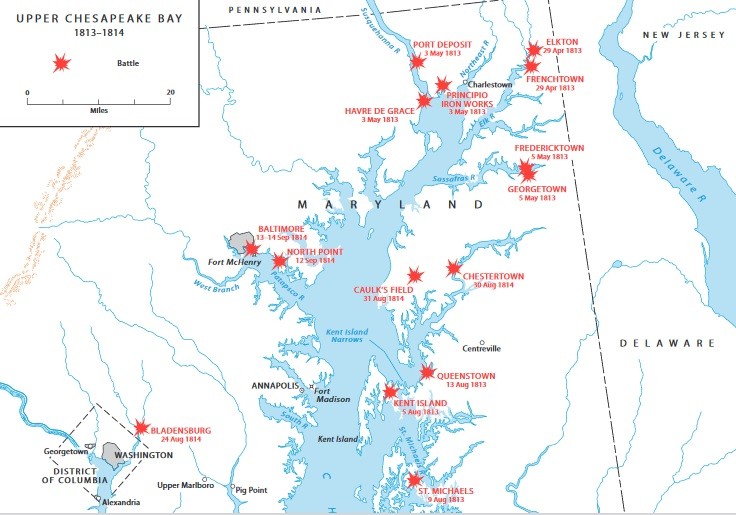
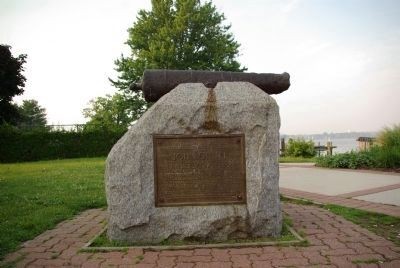
Havre de Grace Historical Marker
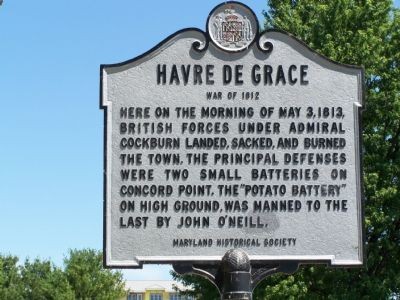
Backstory and Context
Text-to-speech Audio
In the spring of 1813, Great Britain and the United States had been locked in conflict for over a year. As the War of 1812 raged on, Britain sought to divert American attention from the Canadian Theater (where the United States held a decisive numeric advantage) by blockading the Chesapeake Bay. The blockade was led by Admiral Sir John Warren.
Admiral Warren quickly imposed a blockade in February 1813. His blockading fleet gobbled up American merchant ships and blockade runners. Although Warren was a somewhat conservative commander, satisfied with stunting the local maritime economy, he allowed his second in command Rear Admiral George Cockburn to raid the Chesapeake coastline. These raids have several objectives: to destroy any ships or valuable military supplies, to inflict economic damage and lower Americans’ support for the war, and to gather food and supplies needed by the local British fleet. An aggressive commander, Admiral Cockburn carried out his orders with gusto.
In April 1813, Admiral Cockburn led his fleet into the uppermost reaches of the Chesapeake Bay. On April 29, a force of British sailors and marines under Lieutenant George Westphal struck at the small fortified hamlet of Frenchtown, Maryland. They scattered local militia and burnt everything in the town they couldn’t carry; Frenchtown ceased to exist. Turning up the Susquehanna River, the British hoped to pull a similar strike on Elkton but found it too well fortified. Instead, they sailed west, capturing American livestock on Spesutie Island. As the British plundered the island, they received fire from a small American shore battery at Havre de Grace, Maryland.
The Americans’ attack on the British proved a mistake. Had they kept their guns silent, they may have gone unnoticed. Instead, Cockburn reported that he “observed Guns fired and American Colours hoisted” at Havre de Grace. As historian Stanley Quick points out, “Cockburn decided if the town [of Havre de Grace] was worth defending, it was also worth attacking.”[1] A force of 500 Royal Navy sailors and marines under Lieutenant Westphal was ordered to storm the town. The British raiders set off around midnight on May 3 in 16 boats, one of which carried Congreve rockets. A novel British invention, Congreve rockets were notoriously inaccurate, often doing little damage, but their piercing shriek as the flew threw the air often frightened inexperienced troops.
Grace de Havre was protected by two artillery batteries near at Concord Point. The batteries were manned by untested militiamen of the 42nd Maryland Regiment, just under 200 men total. Lieutenant Westphal’s force approached the Americans’ position as morning rose, and his force opened fire on the militiamen. Congreve rockets screamed through the air. The American militia battery returned fire on the incoming attackers. A Congreve rocket, however, struck and killed a local militiaman in the head. Unnerved by his loss, the Americans began to retreat just as the British boats hit ashore.
Lieutenant Westphal led the charge forward, followed by a small party of his men. As he approached the American artillery, only one American militiaman stood his ground: John O’Neill. An Irish immigrant to the United States, he stayed at his guns as his comrades fled. He later recalled, “The grape-shot flew thick about me. I loaded the gun myself without anyone to serve the vent, which you know is very dangerous, and fired her…I kept waving my hat to the militia, who had run away, to come to our assistance. But they proved cowardly and would not come back.”[5]
Lieutenant Westphal approached O’Neill, demanding his surrender. When the Irish immigrant refused, Westphal fired his pistol, but it misfired. O’Neill fired his firearm in response, wounding Westphal in the hand. But Westphal managed to pull out a saber, bringing the intensely personal confrontation to an end. As O’Neill admitted, “an English officer on horseback, followed by the marines, rode up and took me with two muskets in my hand.”[5] The brave American was taken prisoner.
Having routed the militia and taken Havre de Grace, the town was plundered and put to the torch. Admiral Cockburn’s policy called for destroying those towns that resisted British incursions, as Havre de Grace had done. The British plundered the town (British and American accounts disagree as to the extent of the looting) and set it alight, firing Congreve rockets into buildings to start the fire. Local citizen and historian Jared Sparks, there on the day of the attack, lamented “But the most distressing part of the scene was as the close of the day, when those who fled in the morning returned to witness the desolation of their homes and the ruin of all their possessions.”[1] The Niles’ Register, a popular Baltimore newspaper, declared “The ruins of Havre de Grace shall stand as a monument to British cruelty.”[5] Cockburn received a villainous reputation among Americans for his destruction of the town.
As an Irish immigrant (a former subject of the King), John O’Neill was threatened with hanging. His 15-year old daughter Matilda O’Neill visited Admiral Cockburn’s ship, pleading for her father’s life and showing him her father’s militia commission. Determining O’Neill to be a legal soldier, he was released. Supposedly Cockburn also gave young Matilda a golden tortoiseshell snuff box as a token of her bravery. John O’Neill later served as the first keeper of the lighthouse built on Concord Point.
Today, the site of the Concord Point battery is a local park. A state historical marker at the site acknowledges the British raid on Grace de Havre. At nearby Millard E. Tydings Memorial Park, a separate monument to John O’Neill’s bravery stands, complete with a War of 1812 cannon. In 2013, the city commemorated the bicentennial anniversary of the battle.
Sources
1. Stanley L. Quick and Chipp Reid. Lion in the Bay: The British Invasion of the Chesapeake, 1813-1814. Annapolis, MD: Naval Institute Press, 2015.
2. Christopher T. George. Terror on the Chesapeake: The War of 1812 on the Bay. Shippensburg, PA: White Mane Books, 2000.
3. John R. Elting. Amateurs, to Arms! A Military History of the War of 1812. New York: Da Capo Books, 1995.
4. Charles P. Neimeyer. The Chesapeake Campaign 1813-1814. Washington, D.C.: Center for Military History, 2014. Digitized. https://history.army.mil/html/books/074/74-5/CMHPub_74-5.pdf
5. Frederick N. Rasmussen. "Back Story: Defending Havre de Grace from British attack." May 2, 2013. Baltimore Sun. Web. Accessed December 16, 2013. https://www.baltimoresun.com/maryland/bs-md-backstory-havre-de-grace-20130502-story.html
Digital Maryland: https://collections.digitalmaryland.org/digital/collection/mhwe/id/32/
National Park Service: https://www.nps.gov/people/george-cockburn.htm
Charles P. Neimeyer. The Chesapeake Campaign 1813-1814. Washington, D.C.: Center for Military History, 2014.
Christopher Busta-Peck, Historical Marker Database: https://www.hmdb.org/m.asp?m=8182
William Pfingsten, Historical Marker Database: https://www.hmdb.org/m.asp?m=162149
